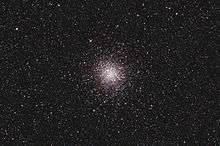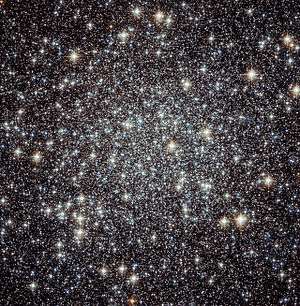Messier 22
| Messier 22 | |
|---|---|
|
Core of Messier 22 | |
| Observation data (J2000 epoch) | |
| Class | VII[1] |
| Constellation | Sagittarius |
| Right ascension | 18h 36m 23.94s[2] |
| Declination | –23° 54′ 17.1″[2] |
| Distance | 10.6 ± 1.0 kly (3 ± 0.3 kpc)[3] |
| Apparent magnitude (V) | +5.1[4] |
| Apparent dimensions (V) | 32 arcmins |
| Physical characteristics | |
| Mass | 2.9×105[5] M☉ |
| Radius | 50 ± 5 ly[6] |
| VHB | 14.2 |
| Metallicity | = –1.49[7] dex |
| Estimated age | 12 Gyr[8] |
| Notable features | One of four globulars known to contain a planetary nebula. |
| Other designations | NGC 6656, GCl 99[9] |
Messier 22 (also known as M22 or NGC 6656) is an elliptical globular cluster in the constellation Sagittarius, near the Galactic bulge region. It is one of the brightest globulars that is visible in the night sky.
History
M22 was one of the first globulars to be discovered, on August 26, 1665 by Abraham Ihle[3] and it was included in Charles Messier's catalog of comet-like objects on June 5, 1764.
It was one of the first globular clusters to be carefully studied first by Harlow Shapley in 1930. He discovered roughly 70,000 stars and found it had a dense core.[10] Then Halton Arp and William G. Melbourne continued studies in 1959.[11] Because of the large color spread of its red giant branch (RGB) sequence, which is similar to that observed in Omega Centauri, it became the object of intense scrutiny starting in 1977 with James E. Hesser et al.[3][12]
Characteristics

M22 is one of the nearer globular clusters to Earth at a distance of about 10,600 light-years away. It spans 32' on the sky which translates to a spatial diameter of 99 ± 9 light-years. 32 variable stars have been recorded in M22. It is projected in front of the galactic bulge and is therefore useful for its microlensing effect on the background stars in the bulge.[8]
Despite its relative proximity to us, this metal-poor cluster's light is limited by dust extinction, giving it an apparent magnitude of 5.5 making it the brightest globular cluster visible from mid-northern latitudes (e.g. Europe and most of North America).[13] However, due to its southerly declination, M22 never rises high in the sky and so appears less impressive to northern hemisphere observers than other summer sky globulars such as M13 and M5.
Planetary nebula
M22 is very unusual in that it is one of only four globulars (the others being M15, NGC 6441 and Palomar 6) that are known to contain a planetary nebula. It was discovered using the IRAS satellite by Fred Gillett et al.,in 1986 as a pointlike source (IRAS 18333-2357)[14] and subsequently identified as a planetary nebula in 1989 by Gillett et al.[15] The planetary nebula's central star is a blue star. The planetary nebula (designated GJJC1) is estimated to be a mere ~6,000 years old.[3]
Black holes
Two black holes of between 10 and 20 solar masses each have been discovered, initially with the Very Large Array radio telescope in New Mexico, and corroborated by the Chandra X-ray telescope, in 2012.[16] Their detection implies that gravitational ejection of black holes from clusters is not as efficient as was previously thought, and leads to estimates of a total 5 to 100 black holes within M22.[17] Interactions between stars and black holes could explain the unusually large core of the cluster.[17]
See also
References
- ↑ Shapley, Harlow; Sawyer, Helen B. (August 1927). "A Classification of Globular Clusters". Harvard College Observatory Bulletin. 849 (849): 11–14. Bibcode:1927BHarO.849...11S.
- 1 2 Goldsbury, Ryan; et al. (December 2010). "The ACS Survey of Galactic Globular Clusters. X. New Determinations of Centers for 65 Clusters". The Astronomical Journal. 140 (6): 1830–1837. arXiv:1008.2755
 . Bibcode:2010AJ....140.1830G. doi:10.1088/0004-6256/140/6/1830.
. Bibcode:2010AJ....140.1830G. doi:10.1088/0004-6256/140/6/1830. - 1 2 3 4 Monaco, L.; Pancino, E.; Ferraro, F. R.; Bellazzini, M. (2004). "Wide-field photometry of the Galactic globular cluster M22". Monthly Notices of the Royal Astronomical Society. 349 (4): 1278–1290. arXiv:astro-ph/0401392
 . Bibcode:2004MNRAS.349.1278M. doi:10.1111/j.1365-2966.2004.07599.x.
. Bibcode:2004MNRAS.349.1278M. doi:10.1111/j.1365-2966.2004.07599.x. - ↑ "Galactic Globular Clusters Database (M22)".
- ↑ Marks, Michael; Kroupa, Pavel (August 2010). "Initial conditions for globular clusters and assembly of the old globular cluster population of the Milky Way". Monthly Notices of the Royal Astronomical Society. 406 (3): 2000–2012. arXiv:1004.2255
 . Bibcode:2010MNRAS.406.2000M. doi:10.1111/j.1365-2966.2010.16813.x. Mass is from MPD on Table 1.
. Bibcode:2010MNRAS.406.2000M. doi:10.1111/j.1365-2966.2010.16813.x. Mass is from MPD on Table 1. - ↑ distance × sin( diameter_angle / 2 ) = 50 ly radius
- ↑ Forbes, Duncan A.; Bridges, Terry (May 2010). "Accreted versus in situ Milky Way globular clusters". Monthly Notices of the Royal Astronomical Society. 404 (3): 1203–1214. arXiv:1001.4289
 . Bibcode:2010MNRAS.404.1203F. doi:10.1111/j.1365-2966.2010.16373.x.
. Bibcode:2010MNRAS.404.1203F. doi:10.1111/j.1365-2966.2010.16373.x. - 1 2 Gaudi, B. Scott (2002). "Interpreting the M22 Spike Events". Astrophysical Journal. 566 (1): 452–462. arXiv:astro-ph/0108301
 . Bibcode:2002ApJ...566..452G. doi:10.1086/338041.
. Bibcode:2002ApJ...566..452G. doi:10.1086/338041. - ↑ "SIMBAD Astronomical Database". Results for NGC 6656. Retrieved 2006-11-15.
- ↑ Shapley, Harlow (1930). "The Mass-Spectrum Relation for Giant Stars in the Globular Cluster Messier 22". Harvard College Observatory Bulletin. 874: 4–9. Bibcode:1930BHarO.874....4S.
- ↑ Arp, H. C.; Melbourne, W. G. (1959). "Color-magnitude diagram for the globular cluster M22". Astronomical Journal. 64: 28. Bibcode:1959AJ.....64...28A. doi:10.1086/107848.
- ↑ Hesser, J. E.; Hartwick, F. D. A.; McClure, R. D. (1977). "Cyanogen strengths and ultraviolet excesses of evolved stars in 17 globular clusters from DDO photometry". Astrophysical Journal Supplement Series. 33: 471. Bibcode:1977ApJS...33..471H. doi:10.1086/190438.
- ↑ Ivans, I.; Sneden, C.; Wallerstein, G.; Kraft, R. P.; Norris, J. E.; Fulbright, J. P. & Gonzalez, G. (2004). "On the Question of a Metallicity Spread in Globular Cluster M22 (NGC 6656)". Memorie della Società Astronomica Italiana. 75: 286. Bibcode:2004MmSAI..75..286I.
- ↑ Gillett, F. C.; Neugebauer, G.; Emerson, J. P.; Rice, W. L. (1986). "IRAS 18333-2357 – an unusual source in M22". Astrophysical Journal. 300: 722–728. Bibcode:1986ApJ...300..722G. doi:10.1086/163846.
- ↑ Cohen, J. G.; Gillett, F. C. (1989). "The peculiar planetary nebula in M22". Astrophysical Journal. 346: 803–807. Bibcode:1989ApJ...346..803C. doi:10.1086/168061.
- ↑ Gary, Stuart (4 October 2012). "Astronomers discover twin black holes". ABC Science News. Australian Broadcasting Corporation. Retrieved 5 October 2012.
- 1 2 Strader, J.; Chomiuk, L.; MacCarone, T. J.; Miller-Jones, J. C. A.; Seth, A. C. (2012). "Two stellar-mass black holes in the globular cluster M22". Nature. 490 (7418): 71–73. arXiv:1210.0901
 . Bibcode:2012Natur.490...71S. doi:10.1038/nature11490. PMID 23038466.
. Bibcode:2012Natur.490...71S. doi:10.1038/nature11490. PMID 23038466.
External links
- Messier 22, SEDS Messier pages
- Messier 22, Galactic Globular Clusters Database page
- Merriefield, Mike. "M22 – Globular Cluster". Deep Sky Videos. Brady Haran.
- Messier 22 on WikiSky: DSS2, SDSS, GALEX, IRAS, Hydrogen α, X-Ray, Astrophoto, Sky Map, Articles and images
Coordinates: ![]() 18h 36m 24.21s, −23° 54′ 12.2″
18h 36m 24.21s, −23° 54′ 12.2″

